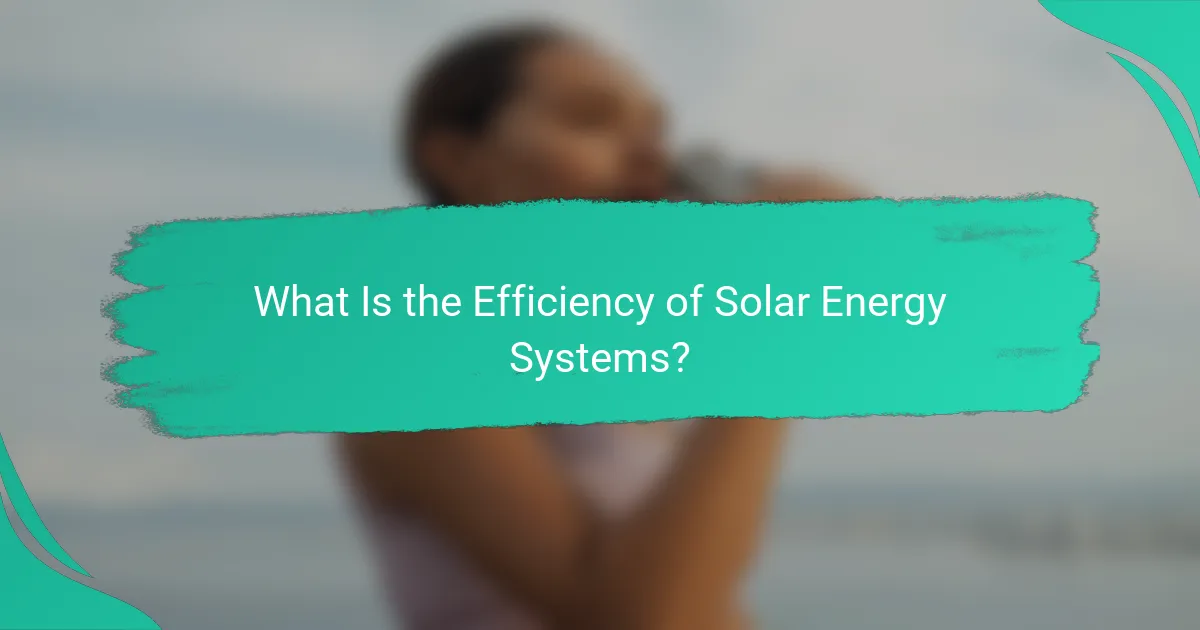Exploring solar energy options reveals a variety of systems designed to meet diverse needs and environments, including photovoltaic systems, solar thermal systems, and community solar programs. The cost of these installations can vary significantly, influenced by factors such as equipment quality and local market conditions. Additionally, the efficiency of solar systems plays a vital role in their effectiveness, with higher rates leading to greater energy production from sunlight.

What Are the Best Solar Energy Options?
The best solar energy options include various systems tailored to different needs and environments. Key choices are photovoltaic systems, solar thermal systems, concentrated solar power, community solar programs, and solar roof tiles, each with unique benefits and considerations.
Photovoltaic (PV) Systems
Photovoltaic systems convert sunlight directly into electricity using solar panels. They are widely used for residential and commercial applications, making them a popular choice for homeowners looking to reduce energy bills.
When considering PV systems, evaluate factors like roof orientation, shading, and local incentives. Installation costs typically range from several thousand to tens of thousands of dollars, depending on system size and location.
Solar Thermal Systems
Solar thermal systems use sunlight to heat water or air for residential or commercial use. These systems are particularly effective for heating applications, such as domestic hot water and space heating.
Installation costs for solar thermal systems can vary, but they generally range from a few thousand to over ten thousand dollars. It’s essential to assess your hot water needs and local climate to determine the system’s efficiency and return on investment.
Concentrated Solar Power (CSP)
Concentrated solar power systems utilize mirrors or lenses to focus sunlight onto a small area, generating heat that can produce electricity. CSP is typically used in large-scale power plants rather than residential settings.
These systems can be more efficient than traditional PV in sunny regions, but they require significant space and investment. Costs can exceed millions of dollars, making them suitable for utility-scale projects rather than individual homeowners.
Community Solar Programs
Community solar programs allow multiple participants to invest in a shared solar installation, making solar energy accessible to those who cannot install systems on their properties. This option is ideal for renters or those with unsuitable roofs.
Participants usually pay a subscription fee or purchase shares, receiving credits on their utility bills based on the energy produced. Costs and savings vary by program, so it’s important to research local offerings and regulations.
Solar Roof Tiles
Solar roof tiles integrate solar technology directly into roofing materials, providing an aesthetically pleasing alternative to traditional solar panels. They generate electricity while serving as a functional roof covering.
While the initial investment for solar roof tiles can be higher than conventional panels, they can enhance property value and curb appeal. Homeowners should consider factors like roof design, local climate, and energy needs when evaluating this option.

How Much Do Solar Energy Systems Cost?
Solar energy systems typically range from several thousand to tens of thousands of dollars, depending on the size and type of installation. Factors influencing the cost include equipment quality, installation complexity, and local market conditions.
Average Installation Costs
The average installation cost for residential solar energy systems in the United States is generally between $15,000 and $30,000 before incentives. This price can vary significantly based on system size, location, and the specific installer chosen.
For example, a smaller system may cost around $10,000, while a larger, more efficient system could exceed $40,000. It’s essential to obtain multiple quotes to find the best price for your specific needs.
Cost per Watt
Cost per watt is a crucial metric when evaluating solar energy systems, typically ranging from $2.50 to $4.00 per watt for residential installations. This figure helps consumers compare the price of different systems and understand their overall investment.
For instance, a 6 kW system priced at $3.00 per watt would cost approximately $18,000. Understanding this metric allows buyers to assess the value and efficiency of their solar investment.
Financing Options
Various financing options are available for solar energy systems, including cash purchases, solar loans, and leases. Cash purchases provide the best long-term savings, while loans can help spread the cost over time, making solar more accessible.
Leasing options allow homeowners to install solar systems with little to no upfront cost, but they may result in lower overall savings compared to ownership. It’s important to evaluate each option’s long-term financial implications before making a decision.
Government Incentives
Government incentives play a significant role in reducing the cost of solar energy systems. In the United States, the federal solar tax credit allows homeowners to deduct a percentage of their installation costs from their federal taxes, which can significantly lower the upfront expense.
Additionally, many states offer their own incentives, such as rebates or performance-based incentives. Researching local programs can provide further savings and make solar energy more affordable.

What Is the Efficiency of Solar Energy Systems?
The efficiency of solar energy systems refers to the percentage of sunlight that can be converted into usable electricity. Higher efficiency rates mean more energy production from the same amount of sunlight, making it a crucial factor in selecting solar panels.
Efficiency Ratings of PV Panels
Photovoltaic (PV) panels are rated based on their efficiency, typically ranging from around 15% to over 22%. Premium models, such as monocrystalline panels, often achieve the highest ratings, while polycrystalline panels tend to be less efficient. Understanding these ratings helps consumers choose the right panel for their energy needs.
Factors Affecting Efficiency
Several factors influence the efficiency of solar energy systems, including temperature, shading, and panel orientation. For instance, higher temperatures can reduce the efficiency of PV panels, while optimal placement at an angle towards the sun can enhance energy capture. Additionally, shading from trees or buildings can significantly decrease output.
Comparative Efficiency of Technologies
Different solar technologies exhibit varying efficiency levels. For example, monocrystalline panels are generally more efficient than polycrystalline and thin-film options. While monocrystalline panels may cost more upfront, their higher efficiency can lead to better long-term savings on energy bills. It’s essential to consider both initial costs and efficiency when evaluating solar technology options.

What Are the Steps for Solar Energy Installation?
The process of solar energy installation involves several key steps that ensure the system is tailored to your needs and complies with local regulations. These steps typically include site assessment, system design, permitting, and installation, each crucial for a successful setup.
Site Assessment
The site assessment is the first step in solar energy installation, where professionals evaluate your property for solar potential. They consider factors such as roof orientation, shading from trees or buildings, and available space for solar panels.
During this phase, installers may use tools like solar pathfinders or shading analysis software to determine the optimal placement of panels. This assessment helps in estimating energy production and identifying any potential obstacles early on.
System Design
Once the site assessment is complete, the next step is system design, where a customized solar solution is created based on the assessment findings. This includes selecting the type and number of solar panels, inverters, and battery storage if needed.
Designers will also consider your energy consumption patterns to ensure the system meets your needs. They may provide a detailed layout and performance estimates, helping you understand the expected energy output and savings over time.
Permitting Process
The permitting process involves obtaining the necessary approvals from local authorities before installation can begin. This step is crucial as it ensures compliance with building codes and safety regulations.
Permits may vary by location, but typically include electrical permits and sometimes zoning approvals. It’s advisable to work with your installer, as they often handle the permitting process and can expedite approvals based on their experience with local regulations.
Installation Timeline
The installation timeline can vary widely depending on factors like system size, complexity, and local permitting processes. Generally, the installation itself can take a few days to a couple of weeks once permits are secured.
After installation, a final inspection is usually required to ensure everything meets local codes. Homeowners should plan for potential delays due to weather or supply chain issues, so maintaining flexibility in scheduling is beneficial.

What Are the Benefits of Solar Energy?
Solar energy offers numerous advantages, including reduced electricity bills, environmental benefits, and energy independence. By harnessing sunlight, homeowners and businesses can lower their reliance on fossil fuels and decrease their carbon footprint.
Cost Savings
One of the primary benefits of solar energy is the potential for significant cost savings on electricity bills. Once installed, solar panels can drastically reduce or even eliminate monthly utility expenses. Depending on local energy prices, homeowners can expect to save thousands of dollars over the lifespan of the system.
Additionally, many regions offer incentives such as tax credits, rebates, and net metering programs, which can further enhance financial savings. For instance, in the United States, the federal solar tax credit allows homeowners to deduct a percentage of the installation costs from their federal taxes.
Environmental Impact
Solar energy is a clean, renewable resource that significantly reduces greenhouse gas emissions. By switching to solar, individuals contribute to a decrease in air pollution and reliance on non-renewable energy sources. This transition is crucial for combating climate change and promoting sustainability.
Furthermore, solar panels have a minimal environmental footprint during operation, as they do not produce harmful emissions. The use of solar energy helps preserve natural resources and supports a healthier planet for future generations.
Energy Independence
Utilizing solar energy enhances energy independence for both individuals and communities. By generating their own electricity, homeowners can reduce their dependence on utility companies and protect themselves from fluctuating energy prices. This self-sufficiency is particularly beneficial during energy crises or natural disasters.
Moreover, as more people adopt solar technology, communities can collectively reduce their reliance on fossil fuels, fostering a more resilient and sustainable energy system. This shift not only empowers individuals but also strengthens local economies.
